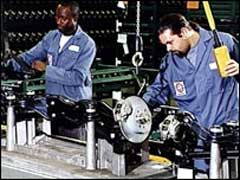 |
August 29, 2013 - Supply Chain Newsletter |
 |
| FEATURED SPONSOR: KEWILL |
 |
Logistics in 2020: The Future is Closer Than You Think |
 |
|
||||||||||||||||||||||||||||||||||||||||||||||||||||||||||||||||||||||||||||||||
The Labor (Day) Supply Chain 2013Monday marks the annual Labor Day holiday both here and in Canada, and a couple of years ago I decided to do a column on the state of the labor supply chain in conjunction with this event. It was popular enough that I repeated it last year and am back here again for 2013. According to Wikipedia, Labor Day was "first nationally recognized in 1894 to placate unionists following the Pullman Strike [a major event in US labor history in which a number of striking workers were killed and much US rail traffic brought to a halt]. With the decline in union membership, the holiday is generally viewed as a time for barbeques and the end of summer vacations." That description of the state of US labor is an interesting one, and largely true based on the data. Yet, as weak as the labor movement has seemingly become in the last few years, in the past 12 months there have been some signs of resurgence.
As just one quick example, we've already seen in the US several brief strikes by fast food restaurant workers in major metro areas demanding a "living wage" of $15 per hour. More are scheduled for this weekend. There are certainly many supporting their cause. Do I think these actions will result in $15 per hour pay rates? Virtually no chance. But I do believe there will be some upward pressure from the bottom that may impact what we pay DC associates in the end. The reality is that production workers in manufacturing average around $19.15 per hour, which is 3.2% below their recent March 2009 peak and back to where they were in 2000, adjusted for inflation, the Bureau of Labor Statistics says. Whatever your overall opinions, manufacturing wages have been flat or down for a decade, while many overall living costs have risen. At an American Axle & Manufacturing plant in Michigan, new hires for assembly start at $10 an hour. Those hired before 2008 get a "legacy" rate of about $18 an hour. Just $10 per hour to work at an auto industry factory? Amazing - I wonder how far back you would have to go to see when they last paid a wage that low. GE's celebrated plan to move production of electric water heaters to Louisville from Mexico came only after US unions agreed to a $13 per hour starting wage for new hires, $8 to $10 below the previous contract. The ironic thing of course is that overall, a big driver of the nascent reshoring trend is the flat or even lower wage rates here in the US, while Chinese wages are rising sharply and consistently. I hope no one is really happy with this situation. In some cases, clearly union wage rates and total costs (including such things as paid "job banks") in some sectors such as automotive got way out of control. I understand all about global competition and the need to attack every extra penny of costs, but again I hope most of us would like to see manufacturing employees make more than $10 per hour, and have their real wages actually grow modestly but consistently over time. But labor is succumbing to a host of threats: • Too many unskilled workers for the number of blue collar jobs. • Ever-present threat that the work could be moved off shore, or even just to a lower cost/non-union area of the US. • Increasing threat of automation replacing the humans. The reality is - and something which most labor advocates never seem to quite get - is that the automation may not payoff at $13 per hour wage rates, but just might at $20. I simply have no answer to that. Labor, pick your poison. To just add some more facts to point number 2, the number of US manufacturing jobs declined an astounding 35% between 1998 and the bottom in 2010, while I assume the number of workers interested in manufacturing jobs rose. The modest good news is that manufacturing employments is up about 4.5% since then - though we might call that stopping the bleeding, but not reversing the trend. The BLS numbers, by the way, say US warehouse workers bring home about $15.00 per hour, about 20% less than the $19.15 the average production worker brings home. Amazon.com starts its DC workers at $11.00 per hour (though the rate can rise over time, and Amazon provides a healthy benefits plan, including offering to pay for college.) Interestingly, the number of workers in warehousing continues to rise, from about 530,000 at the end of 2003 to 690,000 in July. The drop related to the Great Recession was very modest, and employment levels now are actually above where they were in 2008 by 40-50,000. Union membership in the US continues to tumble in the private sector. According to government statistics, union membership fell to just 6.6% in 2012, versus 6.9% in 2011. In the mid-1950s, that number was around 35%, the vast majority in factories as the US dominated global production, and there was enough money to go around for workers, management and investors. Those days are long gone. Unionization in manufacturing fell sharply, from 10.5% in 2011 to 9.6% in 2012. In transportation and warehousing, the rate fell from 20.4% to 19.9%. I assume that relatively high number mostly includes unionized truck drivers, not DC associates, which have relatively little unionization - at least for now (see below). In March, Michigan off all places became the 24th right to work state, after a fierce battle in the statehouse, joining Indiana as the second state from the Midwest to make the move in the past two years. There are now similar rumblings in my home state of Ohio, in part as it sees Indiana poaching factories from Illinois and elsewhere. It continues to look like labor is on the run - but not all in fact is bad news for labor. Early this year, the East and Gulf Coast ports finally reached an agreement with the Longshoremen that appears very favorable to the union, and largely kept intact the contract's archaic provision dating from the 1960s that gives Just recently, a federal appeals court upheld a ruling from the very labor-friendly National Labor Relations Board (NLRB) approving the move by a small group of nurses within a larger healthcare provider setting to form their own union. I frankly just picked up on this trend earlier this year, and which some have termed "micro-unions." It has many business interests very concerned. This idea is that a subset - maybe even a small subset - of associates in any workplace can form their own union. I have heard - but cannot find the back-up - that such a micro-union was formed among shoe clerks at one high end retail department store, and by the receiving staff at one large distribution center. We know it happened in this health care example. Of course, it could be much easier to get a small group of employees to organize versus an entire workforce. That could be the union camel's nose under the factory or DC tent, if you will. It could even lead to forming of numerous unions within a single operation and the chaos that would cause. Pay attention to this one. The NLRB certainly might try to revive its approval of "microwave" union drives, which give management little time to respond to a unionization effort. It did so once, but it has been ruled the NLRB didn't have the proper quorum at the time. It does now. And rules giving the OK to so-called "card check" union approval - achieved without the traditional secret ballot - could also become law through NLRB rulemaking, after it failed in Congress. Perhaps most interestingly, are unions setting their site on the vast pool of distribution center workers, using areas such as port drayage drivers as the first in a series of moves to get to that larger pot of union gold? In a story we wrote just this week on such an effort at the port of LA, economist John Using said that "The big prize is not organizing drivers at ports. It's organizing drivers at ports to give them leverage over all the non-union warehouses. I suspect that's the deeper issue that's going on here." This Labor Day, labor is once again diminished. But don't count it out quite yet. Any reaction to our Labor (Day) Supply Chain 2013 review? How do you see some of these issues playing out? Let us know your thoughts at the Feedback section below. .
|
|||||||||||||||||||||||||||||||||||||||||||||||||||||||||||||||||||||||||||||||||
|
|||||||||||||||||||||||||||||||||||||||||||||||||||||||||||||||||||||||||||||||||
|
|
|
YOUR FEEDBACK
We received quite a bit of Feedback on guest columnist David Schneider's two-part series on Systems Thinking in the Supply Chain - or lack thereof. So much so we might have enough for a "Reader's Respond" column in a couple of weeks.
We publish a few of those letters here this week.
Feedback of the Week - On Systems Thinking in the Supply Chain
I think most companies use some form of systems thinking for supply chain systems. It is the degree to which they apply and use technology advances in their design that is the bigger issue. Secondly, this design is confounded by competing and opposing stakeholders such as the Carriers who control some of the software we use and the tendency of companies not to extend business processes beyond their system borders. Finally, federal governments are stakeholders, who sometimes still impose paper-based systems, which constrain system thinking. That is not to say that many companies could improve the business and system processes within their four walls with a strategic view of how to improve the key drivers of the supply chain. From my own experience, it still seems likes there are too many hands in the pot, and not enough 'intelligence' in our systems. The causal diagram in my humble opinion is too abstract and is not as useful as a good fishbone diagram supported by swim-lane diagrams which can be used in a business process or systems process. John Mayo |
||
| More Feedback on Systems Thinking | ||
This is a great piece, and a topic really important to pursue. We, as SCM practitioners, continue to perpetuate processes and technologies that were devised in the 1960s before the advent of the PC and Excel, let alone the internet and in-memory computing. All the solutions devised and developed in the 1990s were designed to satisfy this model and they continue to perpetuate this approach by focusing on functional needs with little attention given to the horizontal end-to-end process needs. Even though we, Kinaxis, focus more on planning and less on execution, your examples are the type of issue we try to get our customers to understand and address. I have moved on - I hesitate to use the word 'progressed' because it implies a maturity curve - from Systems Thinking to Complexity. It seems to have a richer context and is less 'mechanical' or mathematical. I say this because I believe in GEP Box' assertion that "Every model is wrong, but some are useful." Complexity helps you understand what you don't know or assume, and therefore the limitations of your model. Systems Thinking tends to assume that if only you included a few model variables and a better understanding of how things interrelate you will build the perfect model.
I used to fall into this group having studied Chem Eng at Undergrad and Masters level. But then I started a PhD in IE and OR focusing on decision under uncertainty at Penn State in the 1980s, only to be confronted by things like Queuing Theory that knocked my feet out from under me. I eventually decided that the uncertainty of life was more interesting but it was the realization that even a small amount of uncertainty in the input variables have a the impact on the confidence interval of the optimum that made me give up my research. And then I ended up working for i2 and having many converstations about the use of optimization in SCM. There are so many nuances and competing objectives in a decision that change frequently that I do not believe we can write an objective function for an optimization that captures all the trade-offs that need to be performed. How does one translate customer service objectives, inventory levels, revenue, and margin into a common UOM against which we can run an optimization engine? And that assuming we know all the variables with sufficient certainty that the optimum is meaningful. Well, we don't. Thanks again from bring up this topic. The sooner we get to this level of thinking the better. Trevor Miles
|
||
By the way, Prof. Jay Forrester, the creator of Systems Thinking (ST) and System Dynamics (SD), back in 1956, at MIT Sloan School of Management, discovered the bullwhip effect in operations and supply chains by using ST. This finding, among other important stuff, is in his first book, "Industrial Dynamics" - 1961, still a masterpiece in opertaions management. |
||
SUPPLY CHAIN TRIVIA ANSWER
Q: What share of total US rail tonnage is actually bulk commodities, such as coal, oil and agricultural products?
A: 66% in 2012, according to a recent report from the American Trucking Associations based on data from the Association of American Railroads.
| © SupplyChainDigest™ 2003-2013. All Rights Reserved. SupplyChainDigest PO Box 714 Springboro, Ohio 45066 |
POWERED BY: XDIMENSION
|







 the workers and the union a royalty payment on any container that moves through the port.
the workers and the union a royalty payment on any container that moves through the port.

